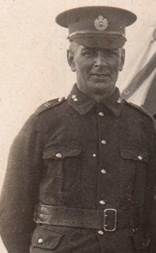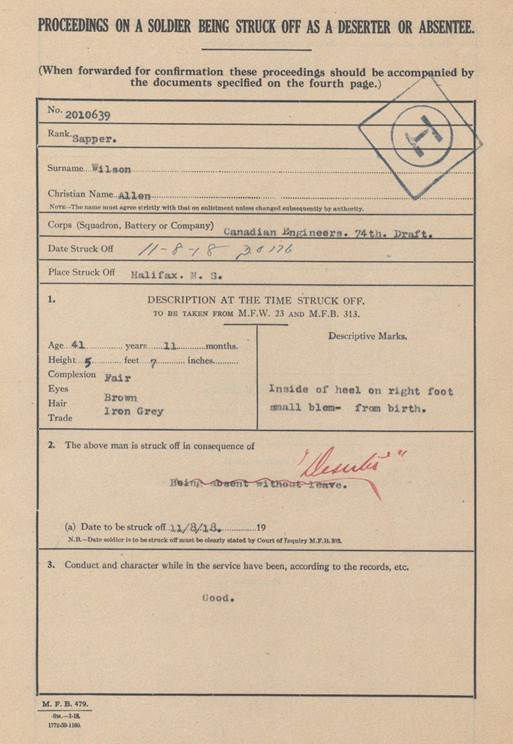
Figure 1. 2010639 Sapper Allan Wilson, Canadian Engineers
(Image from a post card in the author’s collection)
2010639
Sapper
ALLAN WILSON
Canadian Engineers
By
Lieutenant Colonel Edward De
Santis, MSCE, P.E., MinstRE
(March 2023)

Figure
1. 2010639 Sapper Allan Wilson, Canadian Engineers
(Image
from a post card in the author’s collection)
NOTE: The photograph above is a cropped enlargement of a group photograph taken at the Canadian Engineer Training Depot in St. Johns, Quebec in 1918.
1. INTRODUCTION
This is a short and unusual account of the life and military service of Sapper Wilson. It is unusual because he enlisted in the Canadian Army in June 1918 and he deserted in August 1918. It is short because he only served for two months and nothing could be found about him or his family on Ancestry.com.[1]
2. EARLY LIFE
Allan Wilson was born in St. Paul, Minnesota on 18 July 1876. According to his Canadian Attestation form he served for 12 years in the United States Army and was with Company “H” of the 12th U.S. Infantry in the Philippines. During the Spanish-American War, the 12th Infantry was sent to Cuba, in June 1898, and participated in the storming of the Spanish fortress in the Battle of El Caney, where it had the distinction of capturing the Spanish colors.
At the conclusion of the war with Spain, the regiment was immediately deployed in February 1899 to the Philippine Islands to reinforce other Army units fighting elements of the Filipino Army that resisted the United States after they defeated the Spanish at the Battle of Manila. There, the regiment participated in three campaigns (Malolos, Tarlac, and Luzon 1899) of what was to be known as the Philippine–American War and then served as garrison troops, not returning to the United States until 1912.
Whether Wilson was in the Philippines with the 12th Infantry is uncertain because we have only his word on his enlistment papers in Canada that this was the case. The Canadian Army probably just took his word for his prior service. If Wilson had enlisted in the U.S. Army in 1898 to take part in the Spanish American War, and if he spent 12 years in the U.S. Army, then he would have been discharged in 1910 while his regiment was still in the Philippines. After returning home it appears that he got a job as a machinist in Buffalo, New York where his address was 766 Elm Street.[2] He met a woman by the name of Mary Alice Halloran who lived at 431 Herkimer Street in Buffalo. Mary Alice became his fiancé. On his enlistment paper for the Canadian Engineers, Mary Alice was listed as his next-of-kin.

Figure 2. The Home of Mary Alice Halloran at 431 Herkimer Street, Buffalo, N.Y.
(Image courtesy of Google Earth)
3. PHYSICAL DESCRIPTION
According to his Attestation Papers, the following is a description of Allan Wilson at the time of his enlistment in the Canadian Army in 1918 based on a medical examination administered to him in London, Ontario:
Age: |
41 years and 11 months |
Height: |
5 feet 7 inches |
Weight: |
150 pounds |
Physical development: |
Good |
Small-Pox marks: |
None |
Vaccination marks: |
1 in the left arm |
Vaccinated in: |
1910 |
Chest expanded: |
38½ inches |
Range of expansion: |
3 inches |
Complexion: |
Fair |
Eyes: |
Brown |
Hair: |
Iron grey |
Distinctive marks: |
Inside of heel on right foot – small blemish -from birth |
Eyesight: |
Right, 20/20; Left, 20/20 |
Hearing: |
Right, 21+; Left, 21+. Normal |
Religion: |
Roman Catholic |
As
a result of this medical examination, Wilson was found to be fit for
overseas service with the Canadian Expeditionary Force (C.E.F.).
3. ENLISTMENT AND TRAINING
A question arises as to why Allan Wilson, almost 42 years old, presumably an American citizen and engaged to be married, would choose to join the Canadian Army in June 1918. Whatever the reason, on 11 June 1918 he enlisted in London, Ontario for service in the Canadian Engineers. His Attestation Paper provided much of the information described above in his early life. He indicated that he was not married, that he was willing to be revaccinated, that he was not presently in the Active Militia, he had never been discharged from [Canadian] military service as medically unfit and that he had never been rejected for service in His Majesty’s forces. Upon the completion of his enlistment his attestation was certified by a Major in charge of the Mobilization Centre in London, Ontario.
On 20 June he was inoculated against typhoid fever and on the following day he was transferred to the Engineer Training Depot at St. Johns, Quebec. At the depot he prepared his Will naming his cousin, Herbert Martin of 313 Talbot Street West in St. Thomas, Ontario as his heir. It seems strange that he did not name Mary Alice Halloran, his fiancé, as his heir as he had listed her on his Attestation Paper as his next-of-kin. Wilson obviously had relatives residing in Canada and perhaps it was for this reason that he elected to join the Canadian Army.
On 24 June Wilson’s attestation was approved by a medical board at St. Johns and on 11 July 1918 it was approved by the Officer Commanding the Engineer Training Depot and he was posted as a draft replacement for the 7th Field Company, Canadian Engineers. The 7th Field Company formed part of the 3rd Canadian Divisional Engineers, which had been in France since April of 1916.
|
Figure 3. Left to Right:
2010639 Allan Wilson, 928622 Corporal W.A. Smith, and R.L.
Smith. While at the Training Depot Wilson became friends with two other Canadian Engineers as shown in Figure 3. (Their names are written on the back of the postcard as shown above) |
Sapper Wilson sailed from Montreal on 12 July 1918 with the 74th Draft of Canadian troops bound for France. En route the men disembarked at Halifax, Nova Scotia on 18 July. The men of the 74th Draft boarded S.S. Carnarvonshire on 3 August, but Wilson was not among them. He had been reported as “absent without leave” while the men were in Halifax. On 11 August 1918 he was listed as a deserter.
Wilson’s records show that up to this time his conduct and character had been considered to be “Good.” On 11 August 1918, just 3 months before the Armistice, he was struck off the strength of the C.E.F., and in fact the Canadian Army. His records do not indicate that any effort was made to find him.
There could be a number of reasons for his desertion. He was 42 years old and was being sent to war as a Sapper in a field company. He was not a Canadian citizen. He had a fiancé waiting for him in Buffalo. The Germans were in full retreat and it looked like the war was just about over (this may also be the reason that the Canadian Army did not search that hard for him).
Thus ends the short story of the military service of 2010639 Sapper Allan Wilson, C.E.

Figure
4. Desertion Sheet of Sapper Allen Wilson, C.E.
(Image
courtesy of the National Archives of Canada)
Service Papers
Attestation Paper (C.E.F.).
Description on Enlistment.
List of Regimental Documents.
Dental History Sheet.
Casualty Form – Active Service.
Proceedings on a Soldier Being Struck Off as a Deserter or Absentee.
Form of Will.
Medical History Sheet.
Separation and Assigned Pay Form.
Last Pay Certificate.
ENDNOTES:
[1] The majority of this study is based on the information contained in Wilson’s service papers.
[2] This address is presently the site of the Roswell Park Cancer Center.